
21 minute read
Birds
We track birds year-round using the eBird app, which links to the Cornell Lab of Ornithology and the National Audubon Society’s international database. eBird is lauded as one of the fastest growing biodiversity resources in the world. Its data is used by educators, conservation scientists, land managers, and ornithologists to assess bird diversity, distribution, and abundance.
AMERICAN CROW
Advertisement
7. Corvus brachyrhynchos, commonly known as the American crow, is a large passerine bird in the corvids or crow family (Corvidae) that is common throughout North America. The American crow is all black with iridescent feathers. While there are four subspecies of American crow, it is typically 16 to 20 inches in length with a wingspan of 33 to 39 inches. Males tend to be larger than females. Its call is a loud, short, and rapid caaw-caaw-caaw, although it can also produce a wide variety of sounds and sometimes mimics noises made by other animals. The American crow is omnivorous and an active hunter. It is one of only a few species of bird that has been observed modifying and using tools to obtain food. It builds bulky stick nests in trees and bushes. Its average lifespan is seven to eight years, and the population is estimated to exceed thirty million.
7.

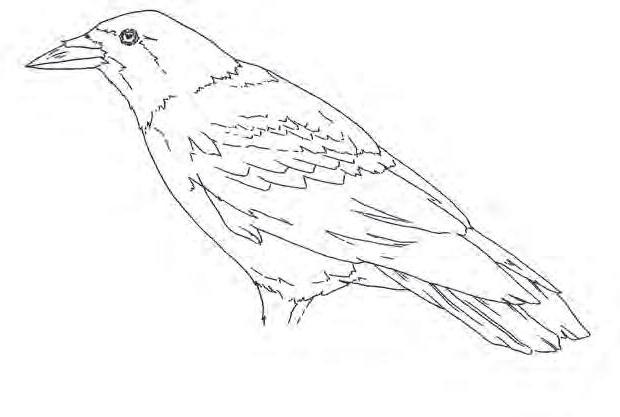
AMERICAN GOLDFINCH
8. Spinus tristis, commonly known as the American goldfinch, is a small bird in the finch family (Fringillidae) that is common throughout North America. It is typically 4 to 6 inches in length with a wingspan of 7 to 9 inches. Male American goldfinches are a vibrant yellow in the summer and an olive color in the winter, while the female is a dull yellow-brown that brightens slightly in summer. It is a migratory bird, ranging from Canada to North Carolina during the breeding season and down to Mexico during the winter. It is a granivore, although it will occasionally eat insects. Its conical beak, which is typically pink but turns a bright orange when molting, and agile feet are adapted for the consumption of seed heads. It is a social bird that will gather in large flocks but may behave aggressively during nest building and breeding. Its song is a series of warbles and twitters. Its habitat includes residential areas and open meadows. Its average lifespan is seven to ten years, and the population is estimated to be forty-two million.
AMERICAN KESTREL
9. Falco sparverius, commonly known as the American kestrel, is a bird of prey in the Falconidae family. It is the smallest and most common falcon in North America and is also found in Central and South America. It is typically 8 to 12 inches in length with a wingspan of 20 to 24 inches. Females have reddish orange backs, brown wings, and brown-streaked undersides. Males have reddish orange or brown backs, blue-gray wings with black spots, and white and black undersides. In both sexes, the head is white with a bluish gray top and black facial markings, as well as two black spots on each side of the white or orangish nape. Its calls range from a klee or killy to a whine and chitter. Its diet includes insects, lizards, small mammals, and small birds. It nests in trees, cliffs, and human structures, and its habitat includes grasslands, meadows, and deserts, as well as urban and suburban areas. Its average lifespan is three to five years. It is estimated that there are 1.2 million pairs in North America.
9.
8.


AMERICAN ROBIN
10. Turdus migratorius, commonly known as the American robin, is a songbird in the thrush family (Turdidae) found throughout North America. While there are seven subspecies, it is typically 9 to 11 inches in length with a wingspan of 12 to 16 inches. Its head is black or gray, with white rings around the eyes. Its bill is yellow with a dark tip, and its throat is white with black streaks. It has a reddish orange breast with a brown back and, in males, white undersides. Females tend to be duller than males, with a brown tint to the head and brown undersides. Active during the day, it assembles in large flocks at night. Its diet includes invertebrates, fruits, and berries. Its nests consist of long coarse grass, twigs, paper, and feathers, lined with mud, grass, or other soft materials. It has an extensive range and generally migrates south for the winter. The male robin has a complex and almost continuous song, often described as a cherrily. Its average lifespan is two years, and the population is estimated to be 320 million.
BARN SWALLOW
11. Hirundo rustica, commonly known as the barn swallow, is a passerine bird in the swallow family (Hirundinidae). While there are six subspecies, it is typically 6 to 8 inches long with a wingspan of 12 to 14 inches. It has a blue head and wings, with a reddish orange forehead, chin, and throat. The North American subspecies features red undersides. Its preferred habitats include pastures, meadows, and farmlands, and it generally migrates south in winter. Its diet includes large flies and aphids. It hunts in pairs, which tend to bond for life, but will also form large flocks, sometimes in the thousands. Often built in buildings such as barns and stables or under bridges and wharves, its nests are formed from mud pellets and lined with grasses, feathers, algae, and other soft materials. It will often build its nests near osprey nests, receiving protection from the larger birds. Its lifespan is four years, and the population is estimated to be 190 million.
10.
11.
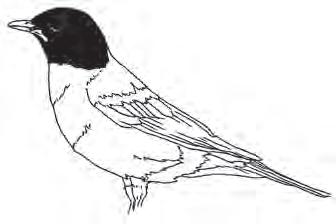

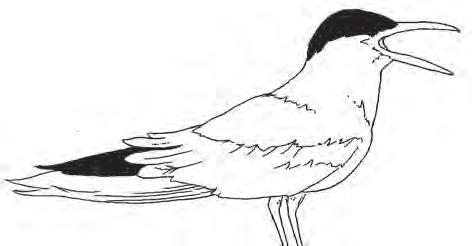
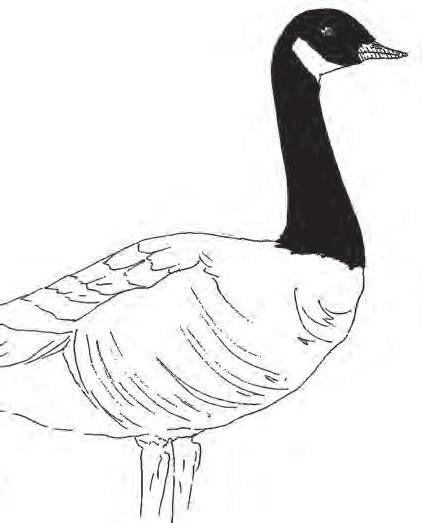
CANADA GOOSE
12. Branta canadensis, commonly known as the Canada goose, is a species of bird in the Anatidae family, which includes ducks, geese, and swans. It is endemic to North America but can also be found in northern Europe, South America, and New Zealand. While there are seven subspecies, it is typically 30 to 43 inches in length with a wingspan of 50 to 73 inches. It is distinguished from other goose species by its black head and neck and white “chinstrap.” It is typically herbivorous, generally eating green vegetation and grains, although it will sometimes eat small insects and fish. The Canada goose is extremely successful at living in human-altered areas, with a proven ability to breed in urban and cultivated areas, which provide food and few natural predators; however, they are among the most commonly hunted waterfowl in North America. Nests are shallow depressions lined with plant materials and down, usually located in elevated areas near water. Its average lifespan is ten to twentyfour years, and the population is estimated between four and five million.
12.
CASPIAN TERN
13. Hydroprogne caspia, commonly known as the Caspian tern, is a species of seabird in the Laridae family, which includes gulls, terns, and skimmers. It is found throughout North America, Europe, Asia, Africa, and Australasia. The largest known tern, it is typically 19 to 24 inches in length with a wingspan of 50 to 57 inches. It has a white head with a black “cap”; a red-orange bill; and a white neck, belly, and tail. The upper wings and back are pale gray. The underwings are pale with dark primary feathers. Its call is a loud heron-like croak. Its habitat includes large lakes and ocean coasts; in the winter it migrates south. It feeds mainly on fish and occasionally on large insects, rodents, and the young and eggs of other birds. Its nests are typically on the ground among gravel and sand and lined with dried vegetation, small pebbles, broken shells, or other debris. Its average lifespan is twelve years, and the population is estimated to be 100,000.
13.

CHIMNEY SWIFT
14. Chaetura pelagica, commonly known as the chimney swift, is a species of bird in the swift family (Apodidae). It is typically 5 to 6 inches in length with a wingspan of 11 to 12 inches. Both sexes are a dark sooty olive with grayish brown undersides. Seldom seen alone, the chimney swift hunts in groups of two or three, migrates in flocks of six to twenty, and sleeps in huge communal roosts of hundreds or thousands of birds. Its diet consists primarily of flying insects as well as airborne spiders. Its habitat ranges across the eastern United States and southeastern Canada. Its nests, shallow brackets made of sticks that are stuck together with saliva, are commonly found in human-built structures. It has a twittering call consisting of a rapid series of hard, high-pitched chirps. Its average lifespan is four to five years, and the global population is estimated to be fifteen million.
14.
COOPER’S HAWK
15. Accipiter cooperii, commonly known as the Cooper’s hawk, is a species of bird in the Accipitridae family, which includes hawks and eagles. It is typically 14 to 18 inches in length with a wingspan of 24 to 37 inches, although the males are smaller than the females. It has blue-gray upper parts and white undersides with fine, thin reddish bars. The tail is blue-gray on top, pale underneath, and barred with black bands. Its head often features a black “cap.” It ranges from southern Canada to northern Mexico, and its habitat includes mixed deciduous forests, open woodlands, and forested mountains, as well as urban and suburban areas. It has a hooked bill that is well adapted for tearing flesh and preys almost exclusively on small to mid-sized birds. It may also supplement its diet with small mammals and amphibians. Its average lifespan is twelve years, and the population is estimated to be 700,000. It is threatened by the degradation and loss of habitat.
15.

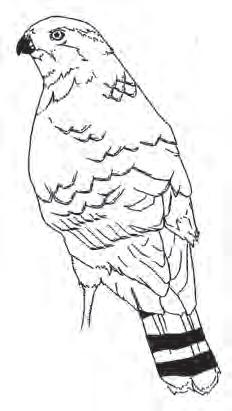
DOUBLE-CRESTED CORMORANT
16. Phalacrocorax auritus, commonly known as the double-crested cormorant, is a species of seabird in the cormorant family (Phalacrocoracidae). While there are five subspecies, it is typically 28 to 35 inches in length with a wingspan of 45 to 48 inches. It has a dark-colored body and bill with a yellow or orange throat and white plumage on either side of the head. It is found throughout North America near rivers, lakes, and coastal areas. It winters anywhere that is ice-free along both coasts as well as in Mexico and the Bahamas, and has also been found in Europe. It eats mainly fish but will also eat amphibians and crustaceans. Its nests are built in trees, on cliff edges, or on the ground. It is often found in colonies with other bird species, and it has a deep, guttural call. Its average lifespan is six years, and the population is estimated to be two million.
16.
EUROPEAN STARLING
17. Sturnus vulgaris, commonly known as the European starling, is a species of passerine bird in the starling family (Sturnidae). Endemic to Europe and western Asia, it has become naturalized in North America. While there are various subspecies, it is typically 7 to 9 inches in length with a wingspan of 12 to 17 inches. It has an iridescent black, purple, or green body that is spotted with white. Its narrow, conical bill is brownish black in winter and lemon yellow (females) or yellow with a blue-gray base (males) in summer. It flocks in huge numbers called murmurations and eats mainly insects as well as invertebrates and small amphibians. It will also eat grains, seeds, fruits, nectar, and food waste. Often found in hollowed trees and tree stumps, buildings, and bird houses, its nests are built from straw, dry grass, and twigs and lined with feathers, wool, and soft leaves. It is often found in urban and suburban areas as well as forests, woodlands, and coastal areas. It is a noisy bird able to produce a range of melodic and mechanical sounds and is also adept at mimicry. Its average lifespan is two to three years, and the global population is estimated to be several hundred million.
17.


HERRING GULL
18. Larus smithsonianus, commonly known as the herring gull, is a species of bird in the Laridae family, which includes gulls and terns. It is typically 24 to 26 inches in length with a wingspan of 47 to 61 inches. A breeding adult is white with black, whitespotted wingtips. Its bill is yellow with a red spot. In winter, the head and neck are streaked with brown. The herring gull has a variety of calls and cries but no song. It ranges across the northern part of North America, and most birds will migrate south. It nests in colonies near water and sometimes on rooftops in cities. Its diet includes invertebrates, fish, and the eggs and young of other birds, as well as carrion and waste. Its nests are scrapes on the ground lined with vegetation such as grass, seaweed, and feathers. It can live up to thirty years, and the population is estimated to be 80,000 pairs.
HOUSE FINCH
19. Haemorhous mexicanus, commonly known as the house finch, is a species of bird in the finch family (Fringillidae). Endemic to western North America, it has been introduced to eastern North America and Hawaii. It is typically 5 to 6 inches in length with a wingspan of 8 to 10 inches. It has a brown or dull brown back with gray wing feathers and a long, square-tipped brown tail. Its undersides are often streaked. Adult males have reddish heads, necks, and shoulders, sometimes extending to the undersides. Its song is a rapid, cheery warble or a variety of chirps. It generally does not migrate south for the winter, although its habitat extends into Mexico. It is found in urban and suburban areas, as well as semi-open areas in the west. It primarily eats grains, seed, and berries, as well as some vegetation and small insects. Its nests are made in cavities using twigs and debris. It can live up to eleven years, and the population is estimated to be anywhere from 267 million to 1.7 billion.
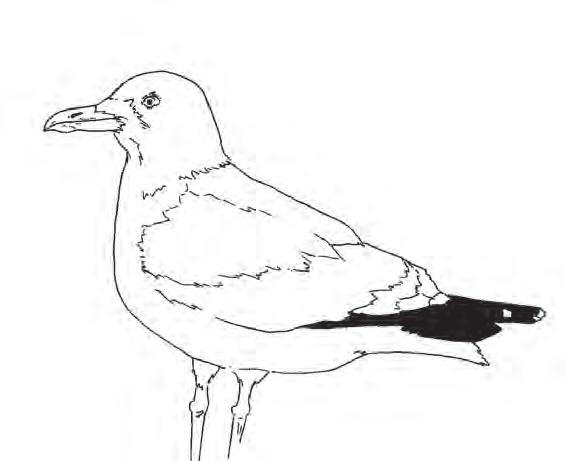

18. 19.
HOUSE SPARROW
20. Passer domesticus, commonly known as the house sparrow, is a species of bird in the sparrow family (Passeridae). It is endemic to Europe and Asia and has been introduced to the Americas, Africa, and Australia. While there are twelve subspecies, it is typically 5 to 7 inches in length with a wingspan of 7 to 10 inches. It has a brown back with black and white markings and gray undersides. Males have dark gray heads flanked with brown, white spots above the eyes, and black throats. Females have brown heads. Its gray bill turns black during breeding season, and it has a short, incessant chirping call. Frequently found in urban and suburban areas, it often lives and breeds in human-built structures and tolerates a wide variety of climates. It does not generally migrate. It nests—made of stems, roots, dead grass, and leaves, and lined with feathers, paper, and other soft materials—are often found grouped together in clumps in eaves and other cavities. It primarily eats seeds but will also eat insects and waste. Its average lifespan is three years, and the population is estimated to be 540 million.
MOURNING DOVE
21. Zenaida macroura, commonly known as the mourning dove, is a species of bird in the dove family (Columbidae) found throughout North America. While there are five subspecies, it is typically 11 to 13 inches in length with a wingspan of 17 to 19 inches. It is generally a light gray-brown with a few dark markings on its back; pale, sometimes pinkish undersides; and dark crescentshaped patches of feathers below the eyes. Adult males often have purple-pink necks and bluish gray heads. It is found in a range of habitats including urban areas, farms, prairies, grasslands, and lightly wooded areas and is a common game bird. It has a distinctive cooing call. Built by the female, its nests are made of twigs, grass, and conifer needles and often found in trees. Its diet consists mainly of seeds, although it will also eat snails or insects. Its average lifespan is two years, and the population is estimated to be 475 million.

20. 21.

PEREGRINE FALCON
22. Falco peregrinus, commonly known as the peregrine falcon, is a bird of prey in the Falconidae family that is found throughout the world. While there are two subspecies, it is typically 13 to 23 inches in length with a wingspan of 29 to 47 inches. Its back and wings range from black to gray. Its throat and undersides are white to light reddish brown with dark brown or black bands. Its tail often features a black tip with a white band. Its beak, notched near the tip, is adapted to killing prey by severing the spinal column. While increasingly living in cities, it is generally found along mountain ranges, river valleys, and coastlines. It feeds on pigeons, doves, waterfowl, and songbirds, and will occasionally eat small mammals, insects, and reptiles. It prefers to nest on south-facing cliff edges, scraping a shallow hollow in the soil, sand, gravel, or vegetation. Tree hollows are also sometimes used, as are tall buildings, bridges, and other human-made structures. It can live up to fifteen years. Although it was once listed as an endangered species, recovery efforts worldwide have been successful. The population is estimated to be 1,650 breeding pairs in the United States and Canada.
RING-BILLED GULL
23. Larus delawarensis, commonly known as the ring-billed gull, is a species of bird in the Laridae family, which includes gulls, terns, and skimmers. It is typically 19 inches in length with a wingspan of 49 inches. Its head, neck, and undersides are white, while its back and wings are gray. Its bill is yellow with a dark ring. It is found primarily in the northern United States near lakes, rivers, and coastlines in urban, suburban, and agricultural areas and occasionally appears in western Europe. It often migrates south in the winter. Its omnivorous diet includes fish, insects, earthworms, rodents, grains, eggs, and waste. Its nests are scrapes on the ground lined with twigs, sticks, grasses, leaves, lichens, or moss. Its average life span is three to ten years. Threatened by hunting and habitat loss, its population plummeted in the nineteenth century but is today estimated at 1.7 million, making it one of the most common gulls in North America.
22.

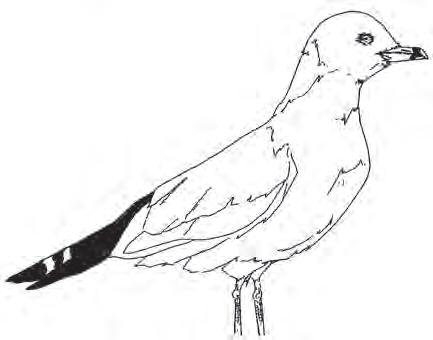

23.
ROCK PIGEON
SONG SPARROW
24. Columba livia, commonly known as the rock pigeon, is a species of bird in the dove family (Columbidae). While there are twelve subspecies, it is typically 11 to 15 inches in length with a wingspan of 24 to 28 inches. It has a bluish gray head and chest, with iridescent yellow, green, and purple feathers on its neck that may extend to its wings. It has two black bars on each gray wing and a black band on the tail, which may also be tipped with white, as well as white underwings. Its call is a dove-like coo. Originally found in Europe, North Africa, and western Asia, it was introduced to North America in the 1600s and has become widely established in cities around the world. Although it is known for its ability to navigate home from long distances, it is sedentary and rarely leaves its local area. It is found in a range of habitats, especially urban areas, and often uses buildings to roost and breed, mimicking the cliffs or rock ledges that it uses in more natural habitats. Its average lifespan is three to five years, and the global population is estimated to be 120 million, although it may be declining. 25. Melospiza melodia, commonly known as the song sparrow, is a species of passerine bird in the Passerelidae family. While it has many different subspecies, it is typically 4 to 7 inches in length with a wingspan of 7 to 10 inches. It has a gray face, brown upperparts, and white undersides that all feature dark streaking, with a dark brown spot or spots in the middle of its breast. It is found in a wide range of habitats throughout Canada and the United States. Northern populations migrate to the southern United States and Mexico, intermingling with nonmigratory populations. It is occasionally found in western Europe. Its diet consists of seeds and fruits, although it will also eat invertebrates. Found on the ground or in trees and shrubs, its nests are made of grass, weeds, and bark and lined with grass, roots, and animal hair. It has a range of easily distinguishable songs—as many as twenty different tunes with up to 1,000 variations—that it learns from neighboring birds. It can live up to eleven years, yet many die within their first year. The population is estimated to be 130 million.
24. 25.

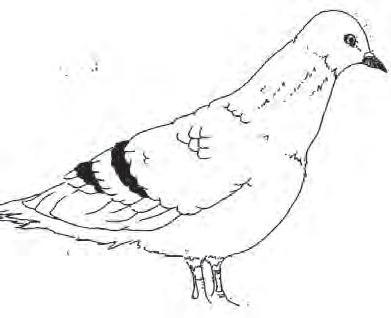
TURKEY VULTURE
26. Cathartes aura, commonly known as the turkey vulture, is a species of bird in the vulture or condor family (Cathartidae). While there are five subspecies, it is typically 24 to 32 inches in length with a wingspan of 63 to 72 inches. It is primarily brownish black with brown and gray underwings. Its head, which is small in proportion to its body, is red with few to no feathers. It has a relatively short, hooked, ivory-colored beak. Ranging from southern Canada to southern South America, it is the most widespread New World vulture and the most abundant vulture in the Americas. It is found in open areas such as shrublands, deserts, foothills, pastures, grasslands, and wetlands. A scavenger, it feeds almost exclusively on carrion, rarely if ever killing prey itself and foraging by smell. It roosts in large groups and nests in caves, hollow trees, and thickets. Its vocalizations are limited to grunts and low hisses. It can live up to sixteen years, and the global population is estimated to be eighteen million.
VIRGINIA RAIL
27. Rallus limicola, commonly known as the Virginia rail, is a species of waterbird in the Rallidae family. It is typically 8 to 11 inches in length with a wingspan of 13 to 15 inches. It is primarily brown to reddish brown, with a grayish head; whitish throat; and dark streaking on its back, wings, or undersides. It has a long, slim, reddish bill. Its habitat includes freshwater and brackish marshes across Canada and the United States, with northern populations migrating to the southern United States and Central America in winter. It is occasionally found in saltwater marshes. Its calls include a kuk kuk kuk and a tick-it or kid-ick, along with grunting noises. It eats primarily insects and invertebrates but will also consume frogs, fish, and small snakes, as well as seeds. It builds its nests at the base of vegetation above shallow water using plants like cattails, reeds, and grasses, often building several “dummy nests.” Because it is a secretive bird, detailed information on many aspects of its life history is lacking and it is difficult to estimate the population.
26.
27.

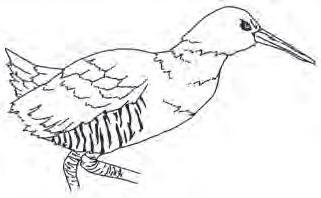
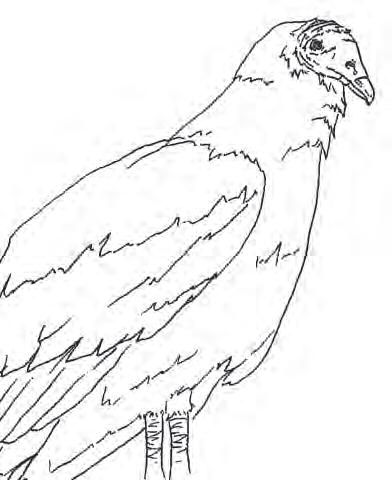

Bioacoustics is the study of sounds produced by living things and how these sounds reflect relationships with their surroundings. For example, animal vocalizations such as bird songs or bat calls—what scientists call biophony—can reveal important information about habitat. Often communicated through spectrograms, which are graphs that show the shape of audio waves and how their frequencies change over time, bioacoustics is emerging as a rough measure of biodiversity. By analyzing biophony in combination with anthropophony (noise generated by people) and geophony (noise from natural phenomenon)—together known as a soundscape—scientists can begin to assess the health of ecosystems. Eastern Red Bat
In addition to visualizing sound for analysis, spectrograms can be used for species identification. For more information on methods of identification, see Liza Lehrer’s interview on page 15.


Song Sparrow
Peregrine Falcon

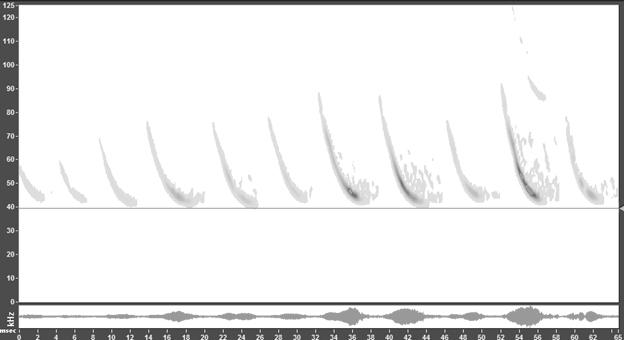
Eastern red bat spectrogram. Source: Urban Wildlife Institute at Lincoln Park Zoo.
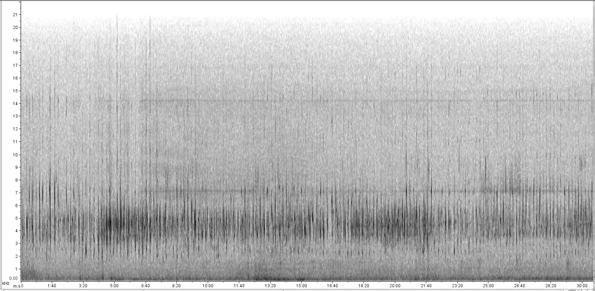
Song sparrow spectrogram. Source: Macaulay Library at the Cornell Lab of Ornithology.











